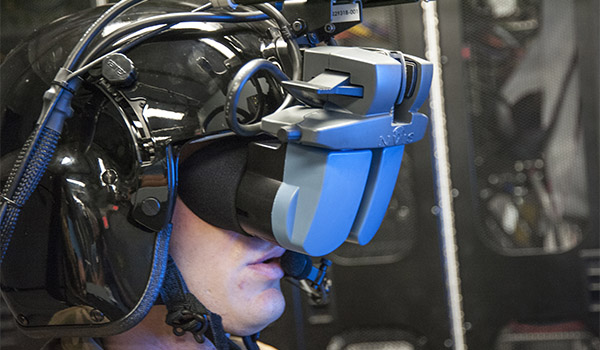
Branch Chief’s Corner / By MG David J. Francis: Over the last several months, I’ve talked about modernizing our fleets, updating our doctrine and refreshing our leadership development strategy. We must do all these things while remaining globally committed with a high OPTEMPO and building readiness to fight and win in a complex Large-Scale Combat Operation (LSCO) operating environment.

U.S. Soldiers with B Company, 1st General Support Aviation Battalion, 214th Aviation Regiment, 12th Combat Aviation Brigade conduct door gunnery training at the Non-Rated Crew Member (NCM3) flight simulator on Aug. 15, 2018 at Storck Barracks, Illesheim. Germany. / U.S. ARMY PHOTO BY GEORGIOS MOUMOULIDIS
Army Aviation’s July issue focuses on simulations, which is a critical enabler for the Aviation Branch. As aviators, we historically rely on simulations to develop proficiency in flight tasks that are too difficult to replicate or too dangerous to execute in a live flight environment. But simulations also allow us to take a hard look at our doctrine, our tactics, techniques, and procedures (TTPs), mission planning processes, and assess how we will fight collectively against a near peer adversary in large scale combat operations. Several initiatives at Fort Rucker highlight how the branch is using simulations to improve our doctrine and change the way we train.
Aircraft Survivability
As we evaluate the Integrated Air Defense Systems (IADS) threat we face on today’s and tomorrow’s battlefields, we must ensure our equipment and tactics are synchronized to effectively mitigate and/or neutralize those threats. Recent experimentation highlights the need to leverage simulations, to the maximum extent possible, to understand how the ‘see/be seen – kill/be killed’ probabilities can be swung in our favor. Developing high fidelity physics-based models, radar cross sections of our aircraft and accurate behavioral modelling for both red and blue forces on the battlefield is critical to our ability to rapidly adapt to new threats, and provide accurate training capabilities to the force in a timely manner. USAACE recently introduced single and multi-ship terrain flight tactics designed to counter current and emerging threats in the LSCO environment. Aviators must address the threat, the kill-chain, and how the aircrew’s actions affect mission outcomes. Key to this training is high fidelity simulation able to reinforce concepts, rehearse maneuvers, and develop SOPs. It is crucial for learning outcomes and risk mitigation as well.
Emergency Response Methodology (ERM)
Simulation is also exceptionally useful in training the new ERM Task 1070 (detailed in the ERM article in this issue). Across all airframes, simulation enhances the depth of training, permitting Emergency Procedure execution in a controlled environment. High fidelity simulation allows crews and instructors to focus on the Fly-Alert-Diagnose-Execute-Communicate-Fly (FADEC-F) steps, and dive into the details of each step to ensure a deep understanding of both the process and the nuances of the emergency. As we approach the release date of the Flight Reference Card (FRC) format to the aircrew checklists this October, simulation will again prove an invaluable tool to train and integrate the full Phase I (1070) and Phase II (FRCs) of ERM, fundamentally changing Emergency Procedure training in Army Aviation.
Aviator Training Next (ATN)
In a previous issue, I highlighted the Aviator Training Next experiment that sought to determine if low-cost, low-fidelity commercial-off-the-shelf virtual reality (VR) technologies could be used effectively to train pilots. To execute this, we put together a cross-functional team led by the Directorate of Simulation that includes the 110th Aviation Brigade, the Directorate of Training and Doctrine, the US Army Aeromedical Research Lab, the Aviation and Missile Center’s Systems Simulation, Software and Integration Directorate in Huntsville and the Operational Research Center at the US Military Academy at West Point. This team collected data during the initial phase of flight training for several classes with 296 students using these VR devices. The initial report indicates that ATN is a valid training methodology and we look forward to continued research in the next phase of the experiment to see if this technology is adaptable in other areas of training.
Future Training Capabilities
USAACE is heavily engaged with the Synthetic Training Environment (STE) Cross Functional Team, which is rebuilding the Army’s simulations training infrastructure from the ground up. The STE is designed to provide a collective, multi-echelon training and mission rehearsal capability for the operational, institutional and self-development training domains. It will provide training to ground, dismounted and aerial platforms and command posts (CP) at the points of need. It will also interact with and augment live training, which is the primary training approach for the Army. Critical to the Aviation Branch is the Reconfigurable Virtual Collective Trainer – Air (RVCT-A) which will replace the AVCATT. Given the complexities of our modern digital fleets, USAACE is leading a formal collaborative team from PEO-AV, PEO-STRI, STE CFT, CAC-T and DAMO-AV to ensure this new training capability fully meets our collective training needs and remains concurrent with our enduring fleet now and into the future as we begin fielding the FVL aircraft.
As a branch, we will continue to leverage every possible technology to insure the training of our Aviation Force. Our people are our most valuable asset, and we will continue to provide the best training capability to the Force. Winning Matters!
Above the Best!
MG David J. Francis is the Army Aviation branch chief and commander of the U.S. Army Aviation Center of Excellence and Fort Rucker, AL.








